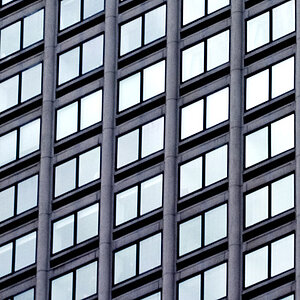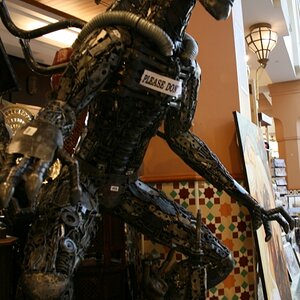Garbz
No longer a newbie, moving up!
- Joined
- Oct 26, 2003
- Messages
- 9,713
- Reaction score
- 203
- Location
- Brisbane, Australia
- Website
- www.auer.garbz.com
- Can others edit my Photos
- Photos NOT OK to edit
>> What LED monitors are we talking about now? The giant 5m high displays, or LCDs with LED backlights? The latter's viewing angles have been discussed and is nothing to do with LEDs, and the former as far as I know hasn't been manufactured in a consumer display size. If anything LED monitors have massive pixel pitches.
OLEDs on the other hand have a different display arrangement. They are usually a pentile display which is largely due to manufacturing constraints on the blue pixel. Expect this to change. CRTs only had the advantage here because their pixels were laid out in a triangular pattern, the phosphors definitely did not overlap each other and they were nearly always run below their maximum resolution (on account of their max res normally subjecting the viewer to horrendously low refresh rates). Run a CRT and an LCD at their highest res and the LCD looks much sharper and clearer.
>> I haven't seen a dead pixel since before the mythical y2k bug. Most if not all manufacturers have a dead-pixel free warranty policy.
>> IPS displays can be had for $300. PVA for less than that. We're on a photography forum where people talk about buying $200 calibrators for their monitors, I don't think the common man rules apply. You're arguing one cheap technology for another, there's problems regardless. Sure there were less colour related problems on a cheap CRT, that is very true and given a horrendously low budget I may concede this point of view, but they certainly are by no stretch of the imagination nice to use.
>> Dead / faded displays are again a function of being cheap not a function of the technology. My father has been through 3 cheap LCDs (wasn't the CCFL that died, but rather the inverters). Good displays should last for a long time. The NEC Multisync displays in the control room at the plant I work have been on 24/7/365 for 7 years, and only one was replaced because an operator put his fist through it. With most things you get what you pay for.
>> We'll have to agree to disagree on the consistent / cost effective bit. I've had greater success with LCD than tubes. I guess it comes down to what we buy, how we use it, and maybe even a bit of luck
As a matter of interest, other than the lack of colourmanagement functionality in Android, why wouldn't you edit a photograph on an OLED display, given how in theory it would be the ideal display for it? ... Oh and given that you'd probably be disowned by the photography world for editing a photo on your mobile
I should mention that I'm kind of biased towards new technologies. I've done quite a bit of work including a thesis in opto-electronics, so I kind of hold dear that OLEDs are going to rock our world
OLEDs on the other hand have a different display arrangement. They are usually a pentile display which is largely due to manufacturing constraints on the blue pixel. Expect this to change. CRTs only had the advantage here because their pixels were laid out in a triangular pattern, the phosphors definitely did not overlap each other and they were nearly always run below their maximum resolution (on account of their max res normally subjecting the viewer to horrendously low refresh rates). Run a CRT and an LCD at their highest res and the LCD looks much sharper and clearer.
>> I haven't seen a dead pixel since before the mythical y2k bug. Most if not all manufacturers have a dead-pixel free warranty policy.
>> IPS displays can be had for $300. PVA for less than that. We're on a photography forum where people talk about buying $200 calibrators for their monitors, I don't think the common man rules apply. You're arguing one cheap technology for another, there's problems regardless. Sure there were less colour related problems on a cheap CRT, that is very true and given a horrendously low budget I may concede this point of view, but they certainly are by no stretch of the imagination nice to use.
>> Dead / faded displays are again a function of being cheap not a function of the technology. My father has been through 3 cheap LCDs (wasn't the CCFL that died, but rather the inverters). Good displays should last for a long time. The NEC Multisync displays in the control room at the plant I work have been on 24/7/365 for 7 years, and only one was replaced because an operator put his fist through it. With most things you get what you pay for.
>> We'll have to agree to disagree on the consistent / cost effective bit. I've had greater success with LCD than tubes. I guess it comes down to what we buy, how we use it, and maybe even a bit of luck
As a matter of interest, other than the lack of colourmanagement functionality in Android, why wouldn't you edit a photograph on an OLED display, given how in theory it would be the ideal display for it? ... Oh and given that you'd probably be disowned by the photography world for editing a photo on your mobile

I should mention that I'm kind of biased towards new technologies. I've done quite a bit of work including a thesis in opto-electronics, so I kind of hold dear that OLEDs are going to rock our world
Last edited:


![[No title]](/data/xfmg/thumbnail/37/37490-9848752f4de5e403f7f20db193e0fb64.jpg?1619738111)






![[No title]](/data/xfmg/thumbnail/33/33493-f055dbbe7f00f271d3959dd3a6482165.jpg?1619736004)
![[No title]](/data/xfmg/thumbnail/33/33492-0ad5e1a91781a72cd081fb3f06aa3628.jpg?1619736003)


![[No title]](/data/xfmg/thumbnail/33/33874-2ac673051e59157729970fcb9b637b43.jpg?1619736180)